Get inspired to EAT LOCAL everyday from your year-round farmers market!
As the days get longer and warmer, spring wakes us up from winter with a welcome burst of fresh new flavors! Before winter even recedes, our local produce growers are using sustainable methods to prepare their fields and orchards. They’re transplanting seedlings from their greenhouses out into naturally rich soils. Other seeds they sow directly in the ground.
At the same time our livestock farmers continue to care for their animals and our food artisans keep on making and baking their yummy creations. You can always count on Seasonal Roots Online Farmers Market to have all your favorite fresh local foods ready to be delivered to your doorstep, whatever they may be.
So check out our Seasonal Eating Guide: Spring Edition. We’ve got tips, recipes, and more to help you dive head first into the delicious tastes of springtime!
Click on the links below to jump straight to whatever interests you…
IN THIS ISSUE
- Organic vs Sustainable vs Local: Which Is Best?
- How to Store Truly Fresh Produce
- Farmer Spotlight: The Flores Family
- Benefits & Uses of Spring’s Luscious Favorites
Organic vs Sustainable vs Local: Which Is Best?
We get this question pretty much every day: “So are your farms Certified Organic?”
When people ask that, we totally get where they’re coming from. We all just want to eat nutritious, safe, non-toxic, eco-friendly food. But it’s not like any of us have the time to research every item we buy. So the government’s “Certified Organic” label has become a convenient shortcut to eating healthy without harming the planet.
If only it were true.
Organic vs sustainable vs local… how do you decide which is best? Here at Seasonal Roots, we’re more concerned about sustainable and local than organic, so we don’t require our local farmers to be Certified Organic. Here’s why:
We partner with local farmers.
Many of them are multi-generational. That means they care for their land, crops, and animals with the next generation in mind. So they use sustainable practices that conserve water, prevent erosion, control pests as naturally as possible, and maintain good soil health. You might call it old school organic.
For example, they’ll rotate their crops to avoid sucking all the nutrients out of the soil, and over the winter they’ll plant cover crops like rye and clover to boost soil health. After they move cows to a new pasture, they’ll bring their free-range chickens to the pasture the cows just left. The happy hens feast on the insects that are feasting on the cow droppings which are fertilizing the grass, which is growing tall again for when the cows return.
The vast majority of our farmers don’t spray much either, if at all, because depending on the chemical that can jeopardize the integrity of their land. If they do spray, it’s minimal and only as required.
One of our sustainable farmers has a friend who runs a Certified Organic farm not far from him. One year, our sustainable farmer sprayed his yellow squash one time all season because it was necessary. His Certified Organic friend, on the other hand, sprayed his squash on a weekly schedule using a spray approved by the USDA. Our farmer isn’t considered Certified Organic, but his weekly spraying friend is allowed to use that title.
“Organic” doesn’t equal “locally grown”.
In fact, it may even be grown in a foreign country and shipped to the U.S. The result? A bigger carbon footprint. That’s not eco-friendly. There’s also no guarantee that the food was produced under ideal conditions for farmers, laborers, or livestock, and an organic label has nothing to do with food safety.
The best way to know if your food is nutritional, eco-friendly, and safe is to know your farmer.
That’s not possible for most of us as individuals. But when we come together as a group like Seasonal Roots, that’s exactly what we do.
We know our farmers. We talk with them, visit their farms, and develop relationships with them. We share their stories with you, like the Flores family later in this guide. That way you can know them too, even if you don’t have time to go visit them yourself.
It’s not quite as easy as the “Certified Organic” shortcut, but it’s a lot easier than trying to do it all by yourself.
Most nutrients begin to degrade from the moment produce is harvested.
The science doesn’t lie: the sooner it gets to you the better. Also, many studies have shown that fruit that’s picked closer to the peak of ripeness (rather than being picked green and ripening on the shelf or by being gassed) is more nutritious than fruit that’s picked before or after peak, whether it’s organic or not.
This is why we hustle to get your produce to you as soon as possible after harvesting, and why being local helps — it doesn’t have to travel far. Much of the food in grocery stores has traveled thousands of miles and many days to get there, losing nutrients every hour of the way.
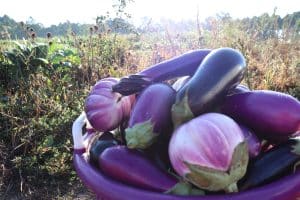
There’s no standard definition for “local”.
Our definition of “local” is within about 150 miles of our delivery areas in Virginia and Maryland. So most of our local partners are in Virginia, and a few are in southern Pennsylvania or eastern North Carolina.
To maintain a healthy variety of options during the winter, we partner with sustainable farmers in Florida. We call that produce “regional” because it can get to us within a day of harvest without resorting to flying. Members who prefer to eat only what’s in season locally can opt out of our winter-time regional offerings, which are clearly labeled.
The bottom line…
We support our local farmers because we know and trust them and their practices. They produce safe food for their families, our families. and your families. Wherever you may be, we hope you’ll join us in supporting your local farmers, too!
How to Store Truly Fresh Produce
Make fresh taste and nutrition last! When you eat fresh local produce, you’re eating the most nutritious, delicious food you can get. It’s picked at the peak of ripeness shortly before you receive it. But it doesn’t last forever. It’s not like grocery store produce, which is usually grown far away, picked early for the lengthy trip, and then waxed and sprayed with preservatives so it will look beautiful and “fresh” for an unnaturally long period of time.
Fact is, grocery store produce looks great long after many of the nutrients inside have faded away. With local food, what you see is what you get. If it looks fresh, that’s because it really is. The key is to handle and store it right.
Now if you’re in a hurry, skip to the end to get to the bottom line: Our handy dandy cheat sheet that shares tips for how to store most local and regional produce items.
But if you’ve got a minute, first check out these additional strategies and background info that will help you get the most out of your fresh veggies and fruits.
- Eat fast
The longer your produce sits in your fridge or pantry, the more nutrients slowly disappear. You get good stuff (like perishable enzymes) from fresh food that you can’t get from anything else. So don’t let your fresh local food go to waste.
But of course, you can’t eat everything all at once!
- Prioritize
To avoid wasting produce, prioritize it so you eat it in the right order. Eat the produce with the shortest life span first, like berries or salad greens or green beans. Once they’re eaten, the more long-lived produce will be waiting for you, with most of their nutrients still intact.
So each week after your order arrives:
- Indulge in the DIVAS right away: Berries, broccoli, cherries, green beans, leafy greens, mushrooms, peaches and plums (if soft and ripe), peas, and sweet corn.
- Dive into the more moderate there-for-you BESTIES next — no rush, but don’t wait forever: Cauliflower, cucumbers, eggplant, grapes, green onions, greens from root veggies, herbs, leeks, peppers, radishes, summer squashes, and tomatoes.
- Save the LOW MAINTENANCE BROS for last. Even if you don’t get them eaten during the week, they can actually kick back and last for a couple weeks, so long as they’re in their happy place. These include: Apples, Brussels sprouts, cabbage, garlic, onions, pears, potatoes, root veggies, and winter squashes.
Now onto the part where we tell you how to store fresh vegetables and fruit after your local farmers harvest it for you.
- QC before you store fresh veggies & fruits
Do a bit of quality control before you store your food. If there’s one mushy or moldy berry, toss it right away. A mushy item is a bad influence, and will lead everything that hangs out with it down the road to ruin.
- DO wait to wash
You probably already know this. But, wait to wash ‘til right before you eat it or cook it. Until then, leave it in its original state and handle it as gently and as little as possible. Excess moisture and bruising accelerate decay and nutrient loss.
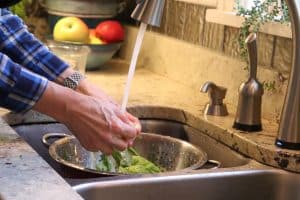
- DO wait to chop or peel
Store fresh vegetables and fruits whole. While we love meal-prepping, if you prep too far in advance, fresh produce loses those precious nutrients. So hold off on peeling or cutting it up until you’re ready to use it. Peeling and chopping expose the insides to oxygen and light and that kills nutrients. Once you do slice into something ahead of time, store it sealed up and in the fridge or freezer until it’s time to use it.
- DON’T wait to refrigerate
For most fruits and veggies, a cold, dark place slows down decay and the loss of nutrients, because it inhibits destructive enzymes and the loss of vitamin C. B vitamins are particularly sensitive to heat and light.
There are exceptions and some items that should steer clear of the refrigerator — namely citrus and any fruit that could use some ripening, plus garlic, ginger, potatoes, onions, winter squash, zucchini, eggplant, and tomatoes… assuming you can eat the tender ones quickly.
- DON’T crowd your crops
Make sure produce has room to “breathe” if it’s stored in a bag. If you cram too many items into a bag, more moisture builds up, more bruising happens, and the produce will spoil more quickly. You can also put a paper towel inside the bag to absorb some of the excess moisture.
- The humidity factor: A detour into the crisper drawer
In general, vegetables last longer in a more humid environment, while fruits prefer a slightly less humid environment. So store fresh vegetables separately from fresh fruit when you can.
The typical crisper drawer is nothing more than a partition inside your refrigerator that offers a more humid environment than the rest of the interior. Some crispers have a sliding humidity control setting that ranges from low to high. Sometimes they’re labeled “vegetables” (high) and “fruit” (lower than the veggie crisper but still higher than the rest of the fridge).
But of course, the real world isn’t as simple as these low-tech sliders, which usually just open or close a little vent in the drawer that allows moisture and ethylene gas to escape. The complicating factor is ethylene gas.
- Beware the ethylene gas!
It’s released by some fruits, including apples, apricots, melons, pears, peaches, plums, plus ripe tomatoes and avocados (but not unripe ones so much.)
Meanwhile, ethylene gas causes ethylene-sensitive produce to ripen faster, which includes most veggies and some fruits (apples, apricots, avocados, cantaloupe, grapes, limes, mangos, honeydew melons, peaches, persimmons, tangerines, and watermelon.)
So to prevent the sensitive ones from turning into overripe mushes, you have to keep them away from the gassy ones. What do you do if a gassy emitter is also a sensitive ethylene hater, like an apple? As you’ll see on the cheat sheet at the end, you can keep it in the fruit crisper, or better yet on a shelf in the fridge.
If you’re the analytical type, here’s an in-depth chart that lists the optimal storage conditions for most veggies and fruits and whether or not they’re an ethylene emitter or an ethylene hater. If you prefer a simpler guideline, here’s the ABC version:
- A… Keep most fruits in the low humidity drawer along with onions you need to keep cold because you don’t plan to eat them for a long time — onions like low humidity and are neutral in the ethylene gas wars.
- B… Keep vegetables in the high humidity drawer along with fruits that are gas sensitive haters and NOT emitters that you need to keep cold because you’re not going to eat them within a couple days: unripe avocados, grapes, persimmons, and watermelon.
- C… Keep gassy emitters who are also sensitive haters on a counter if they’re not ripe yet, and on a shelf in the fridge once they are ripe: apples, apricots, avocados, cantaloupe, mangos, honeydew melons, peaches, pears, and plums.
- When all else fails, freeze it!
If you can’t eat it all fast enough, just throw it in the freezer. It’ll keep there for 8-12 months! When you defrost it later, if it’s not as appetizing to eat raw, it’ll still be great cooked. And it’ll still be just about as nutritious as it would have been if you’d cooked it instead of freezing it in the first place.
And that’s how you store fresh vegetables and fruits so you can eat more fresh vegetables and fruits!
(Read more: How to freeze and save fresh local produce for a year!)
Farmer Spotlight: The Flores Family
The family behind Flores Produce provides all of us with a jaw-dropping array of vegetables and fruits, many of them really unique. They’re planting something new every week throughout the growing season. And every week something else that they planted earlier is reaching maturity, ripe and ready for harvest.
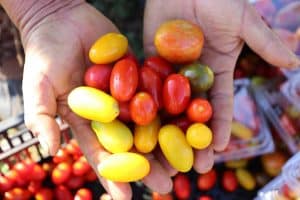
For example, they plant tomatoes four times a year, and cucumbers every three weeks. They only pick them when they’re naturally ripe and that’s happening every week. There’s always something turning ripe, full of flavor and ready to eat. In fact, in a single week they might be bringing us multiple varieties of potatoes, cucumbers, beets, garlic, basil, and kale, plus cabbage, radishes, red sweet onions, Swiss chard, fennel, curly parsley, collards, and hyssop, a mint-like herb that’s been used since ancient times.
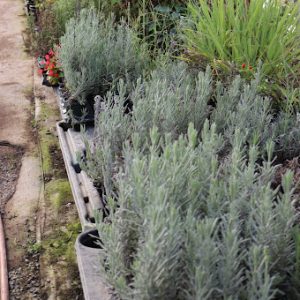
They also keep us fed with greens, beans, carrots, squashes, tomatoes, and more pepper varieties than we can count, many of them inspired by their family’s Mexican heritage. Omar’s father, Gerardo, likes the challenge of growing anything that’s different so his produce stands out. The Flores family’s farm is like an adventure in veggies. And they grow it all themselves.
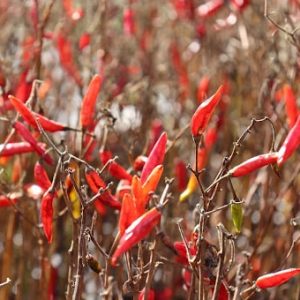
“We’re not a big commercial farm,” explains Omar. “We’re mainly just my dad and my mom, my two little brothers and little sister, and me. It’s a lot of work. When my dad was growing up in Mexico, he helped his father grow corn. After he emigrated to the U.S., he worked in apple and peach orchards and other farms. Eventually he started growing his own vegetables. So he has the knowledge and experience to do most of the farming and the rest of us help him.”
In fact, Omar’s been helping Gerardo with planting and delivery and farmers markets since he was a kid.
They grow their delicious, nutritious produce using sustainable farming techniques, including water conservation methods. Although they’re not certified organic, they use the same chemicals as organic growers. They don’t do the big mono-crop type of farming like the big corporate farming operations do. They start their own plants from seed in their greenhouse, and transplant them into the fields.
“We grow a big variety of produce on our land, side by side with open fields of wildflowers, so we’ve got a pretty healthy ecosystem,” Omar says. “We live right there on the farm, and my wife and I have two toddlers, so we want it to be healthy and safe for all of us.”
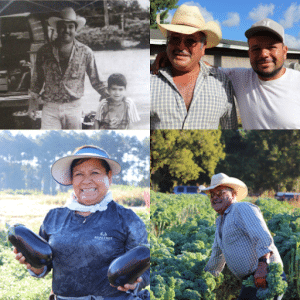
The Floreses now own 40 acres of fields and open land, and lease another 18 acres.
“The first year, though, we didn’t even have a tractor,” Omar recalls. “We did everything by hand. The next year, we bought a tractor.”
Year by year they’ve been buying the equipment they need to expand, mostly more-affordable used equipment.
“Thanks to the families who support us by buying our produce, we were able to put in a small irrigation system,” Omar says. “But most of our fields are watered by Mother Nature, whenever she decides to make it rain.”
If there’s too much or too little rain, they just replant and keep going. That’s farming. Farmers work without knowing how it will turn out. It’s a gamble every year.
Omar sums it up: “If you think about it, we’ve been working since February for free, when we first started planting. We don’t get paid until we have something to sell. So we really appreciate your members. We couldn’t farm without them. That’s really my favorite part of farming — knowing we are feeding people and making them happy with food that tastes better than anything they can buy at the supermarket.”
Benefits & Uses of Spring’s Luscious Favorites
Below are some of the health benefits of seasonal eating in springtime. Every tasty bite of spring’s harvest delivers fiber and so much more!
Because all our produce is harvested nearby within days of home delivery, it gets to you fast while it’s still packed with nutrients and flavor. And so good for you! Much better than produce that has to travel a long way to the grocery store.
Need some new ideas for turning all this local bounty into fresh, delicious meals? Check out some of the Seasonal Roots team’s favorite recipes HERE.
Asparagus
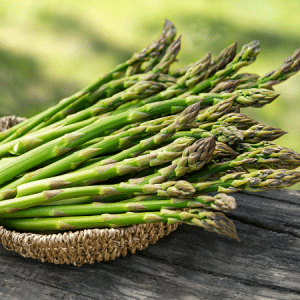 Benefits: Vitamins C, A, B6, folate, folic acid, potassium, fiber, and thiamine, with antioxidant and anti-inflammatory properties.
Benefits: Vitamins C, A, B6, folate, folic acid, potassium, fiber, and thiamine, with antioxidant and anti-inflammatory properties.
Uses: Roast or grill tossed in olive oil, steam, or sauté. Serve alone or add to salads, stir-fries, pastas, and soups.
Virginia/Maryland harvest season: April-June
Beets
Benefits: Vitamin C, folate, potassium, magnesium, with antioxidant and anti-inflammatory properties.
Uses: Roast alone or with other root veggies as a side or add to salads.
Virginia/Maryland harvest season: Year-round
Bok Choy
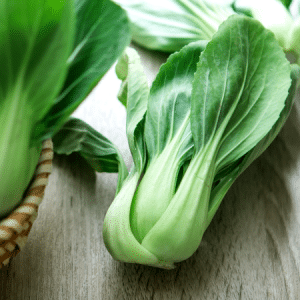 Benefits: Vitamins C, E, B6, beta-carotene, folate, selenium, and the flavonoid quercetin, with antioxidant and anti-inflammatory properties.
Benefits: Vitamins C, E, B6, beta-carotene, folate, selenium, and the flavonoid quercetin, with antioxidant and anti-inflammatory properties.
Uses: Sauté, steam, grill, or roast. Add to stir-fries, soups, salads, egg rolls, and more. Can use in place of any other green leafy veggie.
Virginia/Maryland harvest season: March-June, plus fall
Broccoli
Benefits: Vitamins A, C, E, K, folate, calcium, magnesium.
Uses: Sauté, steam, grill, or roast to release the sugars. Serve as a side or add to soups, stir fries, and one-pan dishes. Eat ‘em raw in salads or as a dip delivery vehicle.
Virginia/Maryland harvest season: May-June, plus fall
Carrots (bunched)
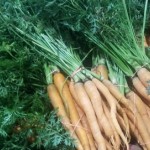 Benefits: Vitamin A, potassium, lutein, with antioxidant properties.
Benefits: Vitamin A, potassium, lutein, with antioxidant properties.
Uses: Delicious fresh or supercharge the sugars by roasting or grilling. Add to stews and soups or serve raw as a snack or with salads and dips.
Virginia/Maryland harvest season: Year-round
Dandelion Greens
Benefits: Vitamins A, E, K, calcium, iron, riboflavin, carotenoids, potassium, with antioxidant properties.
Uses: Sweetest in early spring, boil for a few minutes to reduce bitterness. Sauté, steam, or braise. Serve as a side or add to stir-fries, casseroles, soups, pastas, and salads.
Virginia/Maryland harvest season: March-June
Fennel
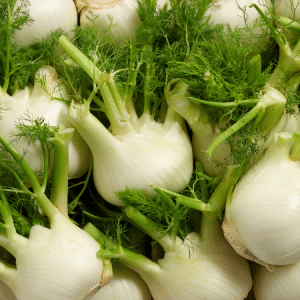 Benefits: Vitamin C, calcium, iron, magnesium, manganese, potassium, with antioxidant properties.
Benefits: Vitamin C, calcium, iron, magnesium, manganese, potassium, with antioxidant properties.
Uses: Roast, sauté, grill. Serve as a side or add to soups, stews, casseroles, stir-fries, and salads.
Virginia/Maryland harvest season: January-May
Garlic Scapes and Spring Garlic
Benefits: Vitamins A, C, K, and loaded with calcium, plus iron.
Uses: Dice raw in a vinaigrette or grill, steam, or sauté. Add to any savory dish!
Virginia/Maryland harvest season: March-April
Lettuce (Fields and Mixes)
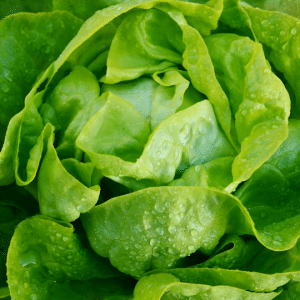 Benefits: Vitamins A, B6, C, E, K, calcium, iron, magnesium, phosphorus, potassium, sodium, zinc, plus thiamine, riboflavin, niacin, and folate.
Benefits: Vitamins A, B6, C, E, K, calcium, iron, magnesium, phosphorus, potassium, sodium, zinc, plus thiamine, riboflavin, niacin, and folate.
Uses: A salad building-block topped with fruits or veggies, nuts or cheeses. Also works as a wrap.
Virginia/Maryland harvest season: March-June, plus fall
New Potatoes
Benefits: Vitamin C, B6, potassium, folate.
Uses: Roast, grill, boil. Serve hot or cold as a side or add to stews, soups, or salads.
Virginia/Maryland harvest season: January-April
Peas (Garden, Snap, and Snow)
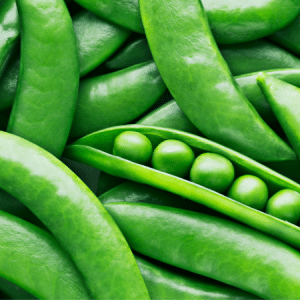 Benefits: Vitamins A, C, K, folic acid, iron, calcium, zinc, copper, manganese, and phytosterols.
Benefits: Vitamins A, C, K, folic acid, iron, calcium, zinc, copper, manganese, and phytosterols.
Uses: Delicious raw or cooked – steamed, stir-fried, or boiled – hot or cold. Eat as a snack, with dips, in salads, or add to stir-fries, soups, and stews.
Virginia/Maryland harvest season: May-September
Radishes
Benefits: Vitamin C, folate, calcium, magnesium, phosphorus, and potassium.
Uses: Sauté, roast, or enjoy raw. Serve as a side or add to salads and other dishes, cooked or raw.
Virginia/Maryland harvest season: March-November
Spring Onions
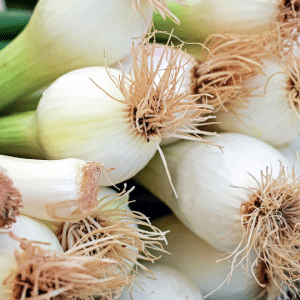
Benefits: Vitamin K, phytochemicals.
Uses: Add raw to salads, dips, salsas, and soups, or cook them in stir-fries.
Virginia/Maryland harvest season: March-November
Strawberries (field)
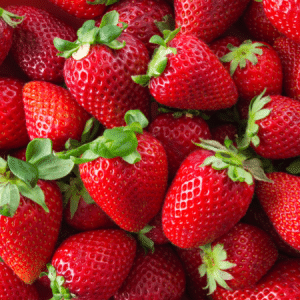 Benefits: Tons of vitamin C and lots of antioxidant properties! Plus potassium, folate, calcium, and magnesium.
Benefits: Tons of vitamin C and lots of antioxidant properties! Plus potassium, folate, calcium, and magnesium.
Uses: Fresh or baked. Great as snacks, even better with a piece of chocolate. Toss onto salads and desserts, add to smoothies, or cook in fruit compotes to serve with meats.
Virginia/Maryland harvest season: April-July
About Seasonal Roots
Since 2011, Seasonal Roots’ online farmers market has connected Virginia families with local family farmers who use sustainable, humane practices. Our neighborhood market managers – who believe in living better through scrumptious, healthy eating, being kind to animals, protecting the environment, and spreading joy – home-deliver freshly harvested produce, pastured eggs, grass fed dairy and meat, plus artisan fare. We empower our members to eat better and live better with more nutritious, flavorful food that’s good for us and good for the planet. More info at seasonalroots.com.
